NRAO eNews
Volume Vol#, Issue Iss#
Day# Month# Year#
NRAO eNews
Volume Vol#, Issue Iss# • Day# Month# Year#

NRAO/GBO COVID-19 Response
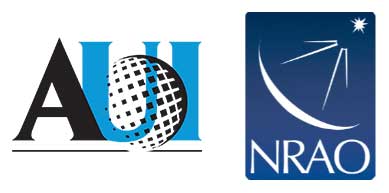
Over the past few months, the global spread of the coronavirus COVID-19 has accelerated, and the U.S. Center for Disease Control (CDC) is predicting widespread infection in this country over the next few weeks/months.
In response to this health threat, NRAO will be adopting travel restrictions and revised workplace practices in an attempt to minimize exposure to, and spread of, the virus in the workplace. A guiding principle of these restrictions is that the decisions and practices of the NRAO / Green Bank Observatory (GBO) / Atacama Large Millimeter/submillimeter Array (ALMA)–Associated Universities, Inc. (AUI) working environment should not be significantly increasing the overall health risks of infection for our staff. This does not, however, replace or override the personal responsibilities we all have as individuals to make appropriate decisions and demonstrate appropriate behaviors as members of a community. The restrictions and changes described below will apply to all facilities in AUI’s Radio Astronomy Operations portfolio, i.e., NRAO, GBO, and the AUI employees associated with ALMA (both International Staff Members [ISMs] and Local Staff Members [LSMs]).
Travel Restrictions:
- Effective March 15th, NRAO/GBO/ALMA-ISM staff will halt all work-based international travel until the end of May. Trips ending before March 15th should continue; trips beginning before March 15th and ending before March 22nd should proceed. Effective immediately, no new authorizations for international travel beginning after March 15th should be approved. International moves associated with staff recruitments will continue, with some form of work-from-home/hotel quarantine for international arrivals.
- We will halt all international travel to our sites: visitors, colloquia speakers, business travelers, etc. should be deferred or canceled, without exception, through the end of May.
- Effective immediately, we will restrict NRAO domestic travel and U.S. visitors to NRAO sites to “essential only” instances. Department Heads will present essential travel cases to the Director’s Office and EHS for approval. “Essential” refers to essential to the government/people of the United States, not essential to NRAO or the Department. Local or regional travel (to destinations within two hours’ drive) may be approved by Department Heads.
- Beginning March 15th, we will restrict international and public visits (public/VIP/non-operational) to the OSF/AOS to those deemed ALMA Observatory critical, as determined by the ALMA Director. Domestic travel within Chile to support ALMA operations will continue normally, until a time at which the ALMA Director, with input from AUI, decides otherwise.
- Effectively immediately, we will postpone/defer/cancel/shift-to-video any large group international meetings at all NRAO/GBO/ALMA locations through the end of May. This includes schools, open houses, conferences, reviews, etc. If there are large domestic-only events, these should be considered non-essential and deferred, but case-by-case review will be considered. At this time, we are proceeding with planning for our student summer programs, but will monitor the situation closely. Large site-based internal-only gatherings may continue, but are generally discouraged and alternatives should be explored.
Workplace changes:
- The most fundamental change in workplace practice to be adopted immediately: if an employee feels sick, with symptoms similar to those indicated for COVID-19 (fever, cough, shortness of breath, flu-like symptoms) – you should self-quarantine, i.e., stay at home.
- We will implement procedural/physical/infrastructure changes to diminish internal transmission of the virus, e.g., adopting general approaches used by hospitals; distribution of hand alcohol, wipes, minimizing hand contact, etc.
We will review the situation and these changes every two weeks, and will discuss extension or cancellation of the restrictions in the first week of May. If the infection rate in the U.S. continues to increase over the next three months, we may extend these restrictions (perhaps modified, based on experience through May).
We will keep the community apprised of the NRAO / GBO status via the NRAO and GBO science websites, NRAO eNews, and occasional email NRAO Announcements to all eNews subscribers. A website to coordinate information has been set up at: https://info.nrao.edu/covid-19
Thank you for your understanding.
Upcoming Events

ALMA Ambassadors Proposals Preparation Workshops
Mar 6 - Apr 7, 2020 | Various Locations

Compact Objects and Energetic Phenomena in the Multi-Messenger Era
Jul 14 - 16, 2020 | Saint Paul, MN
Postponed Events
The following NRAO-related conferences have been postponed owing to concerns about the COVID-19 coronavirus. Please consult the conference websites (links below) for details.

From Collapsing Cores to Forming Disks
Mar 10 - 13, 2020 | Charlottesville, VA

The ALMA 2030 Vision: Design considerations for Digitizers, Backend and Data Transmission System
Mar 11 - 13 | Mitaka, Japan

NRAO Community Days at Universidad de Guanajuato
Mar 10 - 11, 2020 | Guanajuato, Mexico

NRAO Community Days at NAOJ
Mar 31 - Apr 1 | Mitaka, Japan

From Cells to Galaxies 2020: Exploring the Synergies between Radio Astronomy and Medical Imaging
May 5 - 7, 2020 | Santa Fe, NM

17th Synthesis Imaging Workshop
May 13 - 20, 2020 | Socorro, NM

Multiphase Gas in Galaxy Groups
Jun 23 - 25, 2020 | Charlottesville, VA
ngVLA Project News
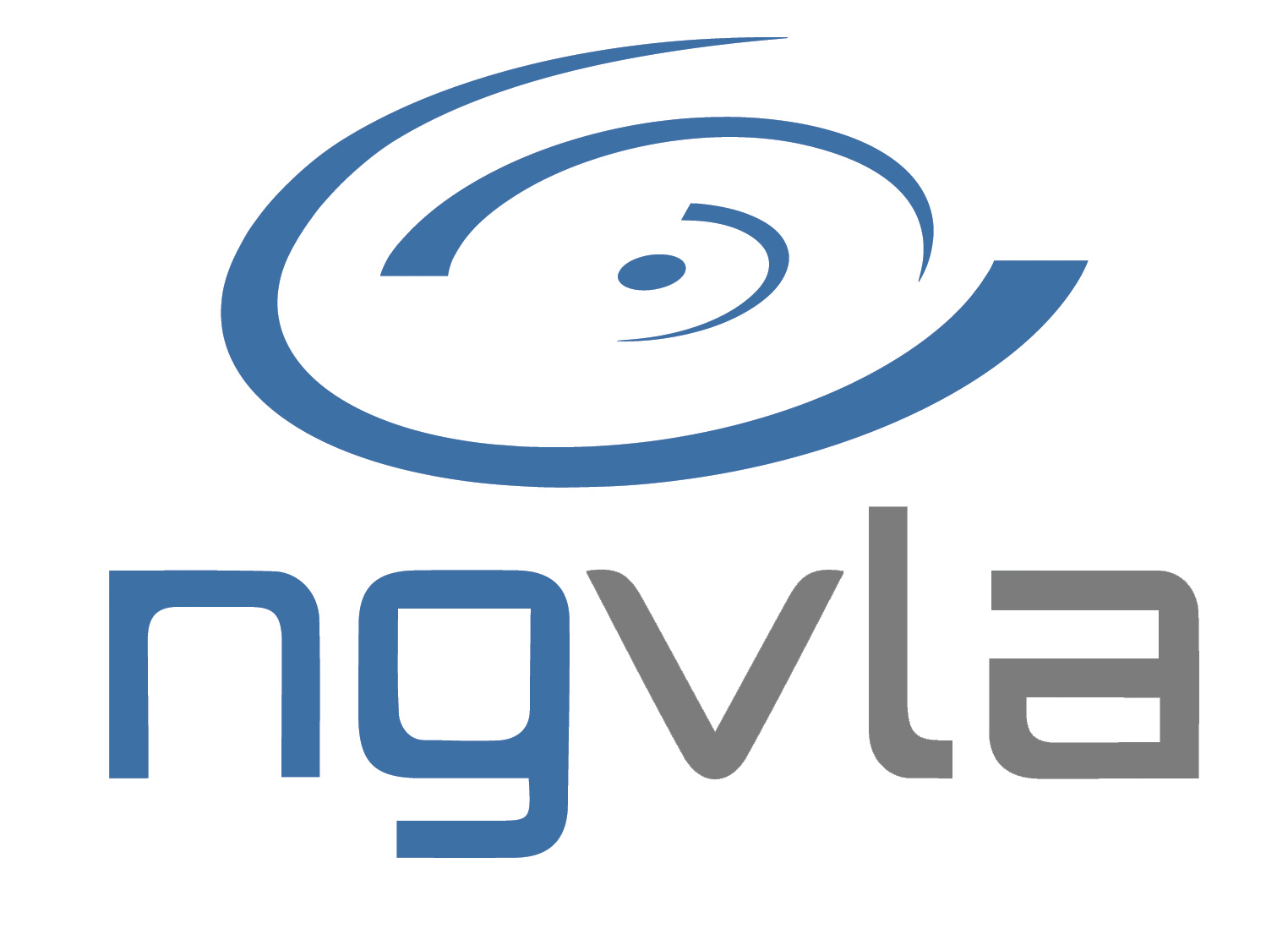
Astro2020 Presentation
On 3 February, the next generation Very Large Array (ngVLA) Project made a presentation to the Astro2020 Panel on Radio, Millimeter and Submillimeter Observations from the Ground. We thank the panel for the opportunity to present to them and are grateful to the many community members who attended the presentation either in person or online.
Compact Objects and Energetic Phenomena in the Multi-Messenger Era
On 14 – 16 July 2020, the NRAO and the ngVLA Project will convene a science conference titled Compact Objects and Energetic Phenomena in the Multi-Messenger Era in Saint Paul, Minnesota, USA. The deadline to submit oral abstracts and requests for travel support is 10 April.
Dr. Anne Kinney, head of the National Science Foundation’s Directorate for Mathematical and Physical Sciences, will give a keynote talk to open the conference. Kinney is responsible for determining how the Directorate pursues NSF’s 10 Big Ideas for future investment. One of the Big Ideas, Windows on the Universe, is focused on maturing the nascent field of multi-messenger astrophysics. Nature Astronomy has commissioned a conference report and will be sponsoring a prize competition for poster presentations.
ALMA Program News
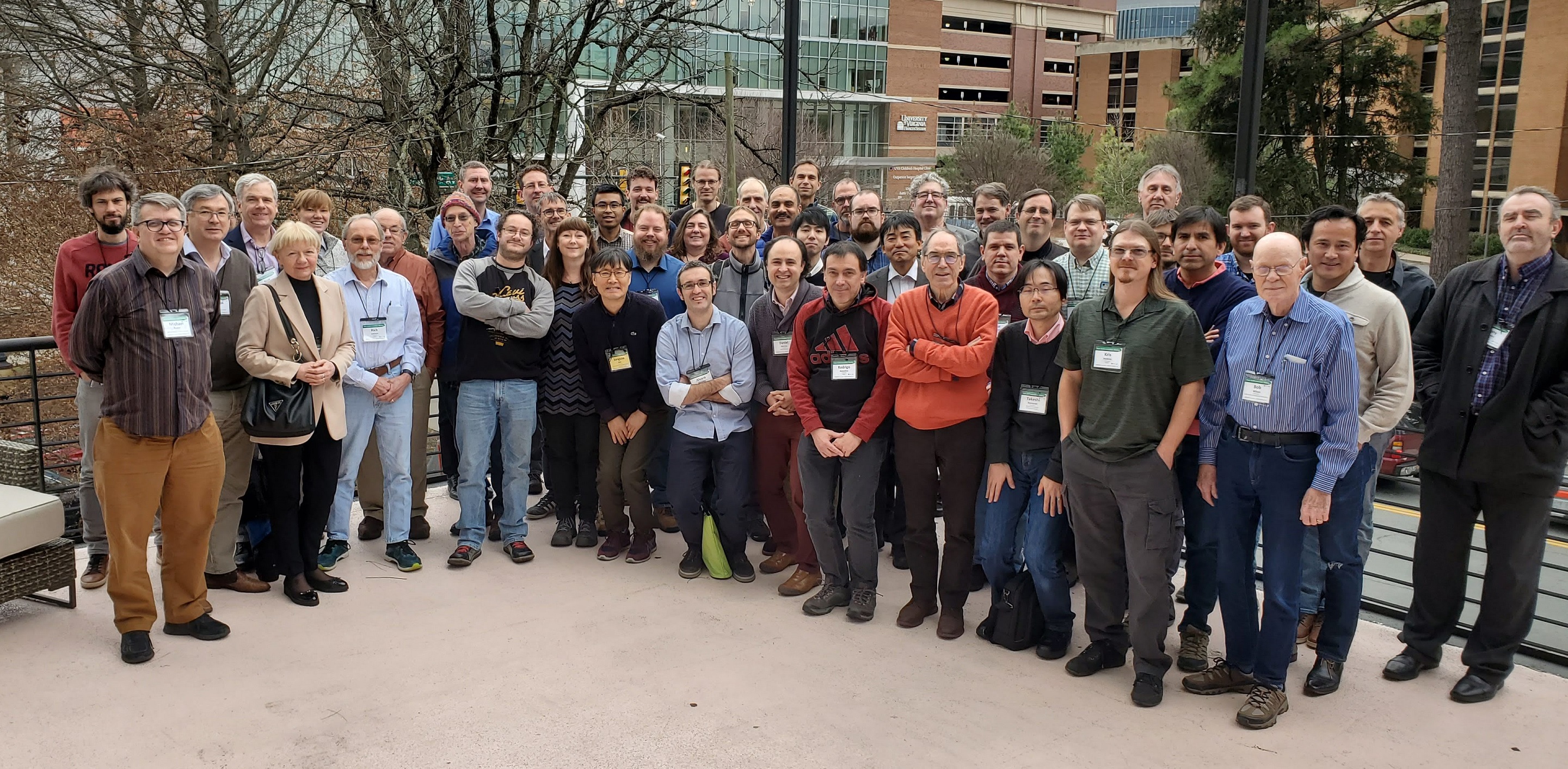
Karen Prairie
Group Photo: The ALMA2030 Vision: Design Considerations for the Next ALMA Correlator
[click to enlarge]
Cycle 8 Call for Proposals
The ALMA Call for Proposals will be opened to the community 17 March at 15:00 UT. The Proposal submission deadline will be 15 April 2020.
ALMA Cycle 8 will start in October 2020 and span 12 months. The Joint ALMA Observatory anticipates having 4300 hours for approved science observations on the 12-m Array and 3000 hours on the Morita Array, also known as the Atacama Compact Array (ACA). In Cycle 8, ALMA will also offer a stand-alone ACA Supplemental Call for Proposals. The Supplemental Call will open 15 September 2020 and the proposal deadline will be 8 October 2020.
The ALMA Proposal Review Process at Cycle 8 will use a dual-anonymous procedure. The guidelines for how to anonymize your proposal are online.
The ALMA configuration files to be used in simulations for Cycle 8 proposals, are the same as those provided at Cycle 7, noting that the longest baseline configurations C43-9 and C43-10 will not be offered.
Cycle 7 Science Observing
ALMA is currently in the February Maintenance Period with science operations scheduled to resume 1 March. At that time, the anticipated array configuration is C43-4.
ALMA Development
A Call for Proposals for ALMA Development Studies was released December 2019. The deadline for proposals is 1 May 2020 for funding during Fiscal Year 2021 — 1 October 2020 through 30 September 2021 — depending on the U.S. Federal budget process. We welcome any member from within the North America ALMA Operations Partnership to submit a proposal to investigate a potential ALMA upgrade aligned with the ALMA2030 goals. Potential Study proposers are requested to submit a Study Proposal Notice of Intent by 16 March 2020. Several meetings designed to stimulate community discussion will be held in the next few months.
The ALMA2030 Vision: Design Considerations for the Next ALMA Correlator
The ALMA Development Roadmap has identified the multiplication of the IF bandwidth of ALMA (at least by a factor 2) as one of the main priorities for ALMA upgrades in the 2020s. This increase of the instantaneous bandwidth will be realized with the coordinated upgrade of the correlators and the electronics feeding them: digitizers, backend and Data Transmission System (DTS), and the receivers ultimately supplying the signals.
A series of three conferences will be held to discuss considerations for all three elements needed to increase ALMA's bandwidth. The first, a conference to discuss considerations for the design of the next ALMA correlator, was held in Charlottesville, Virginia 11 – 13 February 2020. Experts on the ALMA system and modern digital correlator design assembled to inform the submission of viable designs for the next ALMA correlator in the near future. Presentations are available on the website.
The second of these conferences, The ALMA 2030 Vision: Design considerations for Digitizers, Backend and Data Transmission System, was planned for 11 -13 March 2020 at the National Astronomical Observatory of Japan in Mitaka, Japan but has now been postponed owing to the concerns about the coronavirus. This conference will be rescheduled as soon as practical.
The third of these conferences, on the ALMA front ends, including receivers, will be held late next Spring in Europe; details to be announced.
ALMA User-Defined Imaging Available in NRAO Archive
The NRAO Science Ready Data Products (SRDP) project is excited to announce the availability of ALMA user-defined imaging in the NRAO archive. This pilot project enables users to create custom spectral cubes from ALMA data as part of SRDP. The SRDP project aims to provide enhanced data products from ALMA and the VLA, providing users with broader access to science quality data. This feature adds to the previously available archive capability of downloading calibrated measurements for ALMA and the VLA.
Custom data cubes can be created for ALMA Cycle 5 data or later. To access this feature, visit the NRAO archive, search for an ALMA dataset using the available search criteria, and select the 're-imaging' button for the associated ALMA dataset of interest. Users will be prompted to define their datacube by selecting the source, spectral window, and to select the spectral range of their cube in frequency or velocity units. The requested cubes (as well as associated continuum images) are generated using a customized ALMA imaging pipeline recipe with the NRAO computing clusters. The resulting image products will go through a Quality Assurance (QA) process to ensure that we deliver scientifically viable data to users.
The user-defined imaging capability is only available for data that have been successfully processed with the ALMA calibration pipeline. As such, data that were manually calibrated cannot be imaged through this interface. Also, due to each image requiring QA, and the possibility of manual intervention being needed to work around issues with the pilot deployment, there may be some time lag between the processing job completing and images being delivered to the user. This capability is available to all users of the NRAO archive, regardless of ALMA region, and whether or not they are affiliated with ALMA. Proprietary data can also be re-imaged, but only by authorized users. Anonymous requests for non-proprietary data are also currently possible, but may change in the future. Please see the SRDP wesbite for further detail.
ALMA Ambassadors Proposal Preparation Workshops
In advance of the ALMA Cycle 8 Call for Proposals deadline (15 April 2020), the North American ALMA Science Center (NAASC), along with current ALMA Ambassadors, have organized ALMA proposal preparation workshops at a number of North American, and Chilean, institutions in March and April 2020. The goal of these events is to provide users with the knowledge they need to carry out cutting-edge scientific research using the ALMA facilities. We are particularly interested in reaching new users, so no experience with radio astronomy is required to participate!
These ALMA events are one-day workshops designed in cooperation with institutions across North America and Chile, and hosted by experienced postdocs as part of the ALMA Ambassadors program. Registration to these events is free. These events include science talks, an introduction to submillimeter interferometry, and hands-on tutorials designed to assist you in proposal preparation and observation planning for ALMA Cycle 8. You will need to bring your laptop to participate in the hands-on sessions, and we will provide access to the free software that you can download.
If you are interested in attending an ALMA Proposal Preparation Workshop, the date, location, ALMA Ambassador, and event website for each planned community day are listed below.
| Dates | Location | Ambassador (Affiliation) |
|---|---|---|
| 6 March | University of Massachusetts - Amherst | Christopher Faesi (UMass) |
| 19 March | Carnegie Observatories, Pasadena | Gregory Walth (Carnegie) & Serena Perrota (UCSD) |
| 20 March | University of Maryland | Veronica Allen (NASA GSFC) |
| 23 March | University of Toronto | Toby Brown (McMaster) |
| 24 March | Ohio State University | Amy Sardone (OSU) & Toby Brown (McMaster) |
| 25 March | Universidad de La Serena | Jorge Gonzalez Lopez (Carnegie/UDP) |
| 26 March | University of Wyoming | George Privon (UFL/NRAO) |
| 27 March | Haverford College | David Stark (Haverford) |
| 27 March | John Hopkins University | Andrey Vayner (JHU) & Alexander Thelen (NASA GSFC) |
| 27 March | University of Oklahoma | Ben Tofflemire (UTexas) |
| 1 April | Universidad Diego Portales | Jorge Gonzalez Lopez (Carnegie/UDP) |
| 2 April | NASA Goddard SFC | Veronica Allen (NASA GSFC) & Alexander Thelen (NASA GSFC) |
| 2 April | Columbia University | Thomas Rice (Columbia) |
| 3 April | University of Washington | Danielle Lucero (VT) |
| 7 April (TBC) | Universidad de Antofagasta | David Rebolledo (JAO/NRAO) |
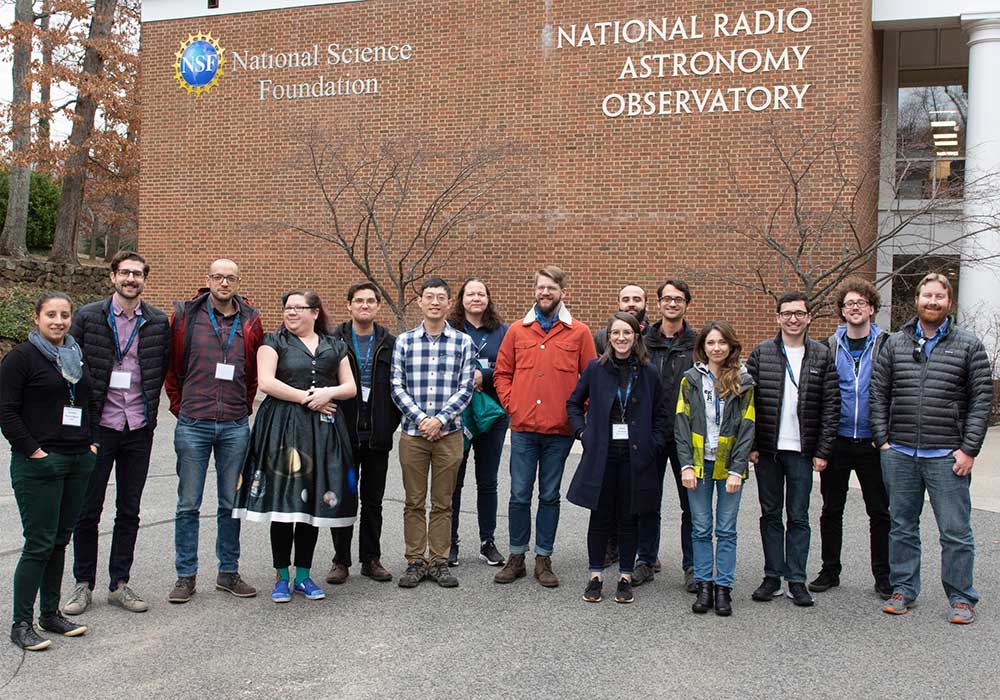
The 2020 ALMA Ambassadors during their training Feb 11-13 at NRAO headquarters, Charlottesville. [Left to Right]: Loreto Barcos-Muñoz (NRAO - ALMA Ambassadors Program Lead Organizer), Ben Tofflemire (UT-Austin), Jorge Gonzalez Lopez (Carnegie, UDP), Veronica Allen (NASA GSFC), Dave Stark (Haverford), Yao-Lun Yang (UVA guest), Danielle Lucero (VT), Thomas Rice (Columbia), Amy Sardone (OSU), Toby Brown (McMaster), Chris Faesi (UMass), Serena Perrota (UCSD), Andrey Vayner (JHU), Alexander Thelen (NASA GSFC), & Greg Walth (Carnegie).
[click to enlarge]
Robert L. Brown Outstanding Doctoral Dissertation Award
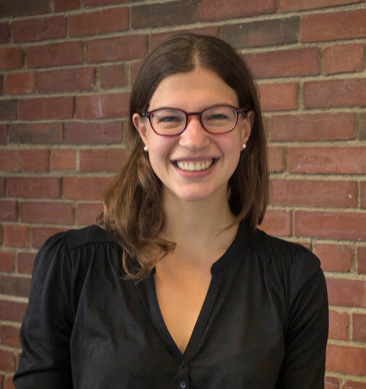
Dr. Jennifer Beth Bergner
[click to enlarge]
NRAO is pleased to announce that Dr. Jennifer Beth Bergner is the winner of the 2019 NRAO/AUI Robert L. Brown Outstanding Doctoral Dissertation Award, for her Harvard Dissertation, Tracing Organic Complexity During Star and Planet Formation. Dr. Bergner’s research impressively delineates how the properties of complex organic molecules can serve as a guide to the poorly understood chemical history of planetary systems and low-mass stars. Her innovative laboratory experiments have opened an exciting new path for understanding the complicated organic chemistry during the delivery of prebiotic material to future planets via a protoplanetary disk. The Award Committee was extremely impressed by Dr. Bergner’s thoughtful application of her laboratory results for interpreting spectral observations of low-mass stars obtained at the Atacama Large Millimeter/submillimeter Array.
The Robert L. Brown Outstanding Doctoral Dissertation Award is administered by Associated Universities, Inc. (AUI) and NRAO on behalf of Bob Brown’s friends and family to honor Bob’s life and career. The Award is given each year to a recent recipient of a doctoral degree from any recognized degree granting institution in the United States, and is substantially based on new observational data obtained at any NRAO/AUI facility and considered to be of an exceptionally high scientific standard. The Award is available to degree recipients of any nationality and consists of $1000 USD, a framed certificate, and an invitation to give a colloquium at the NRAO. Applications for the 2020 Award should be sent to RLBrownAward@nrao.edu before 31 December 2020. Further information about the Robert Brown Award may be found online.
Irradiated Molecular Chemistry in Planetary Nebulae: Prospects for the ngVLA
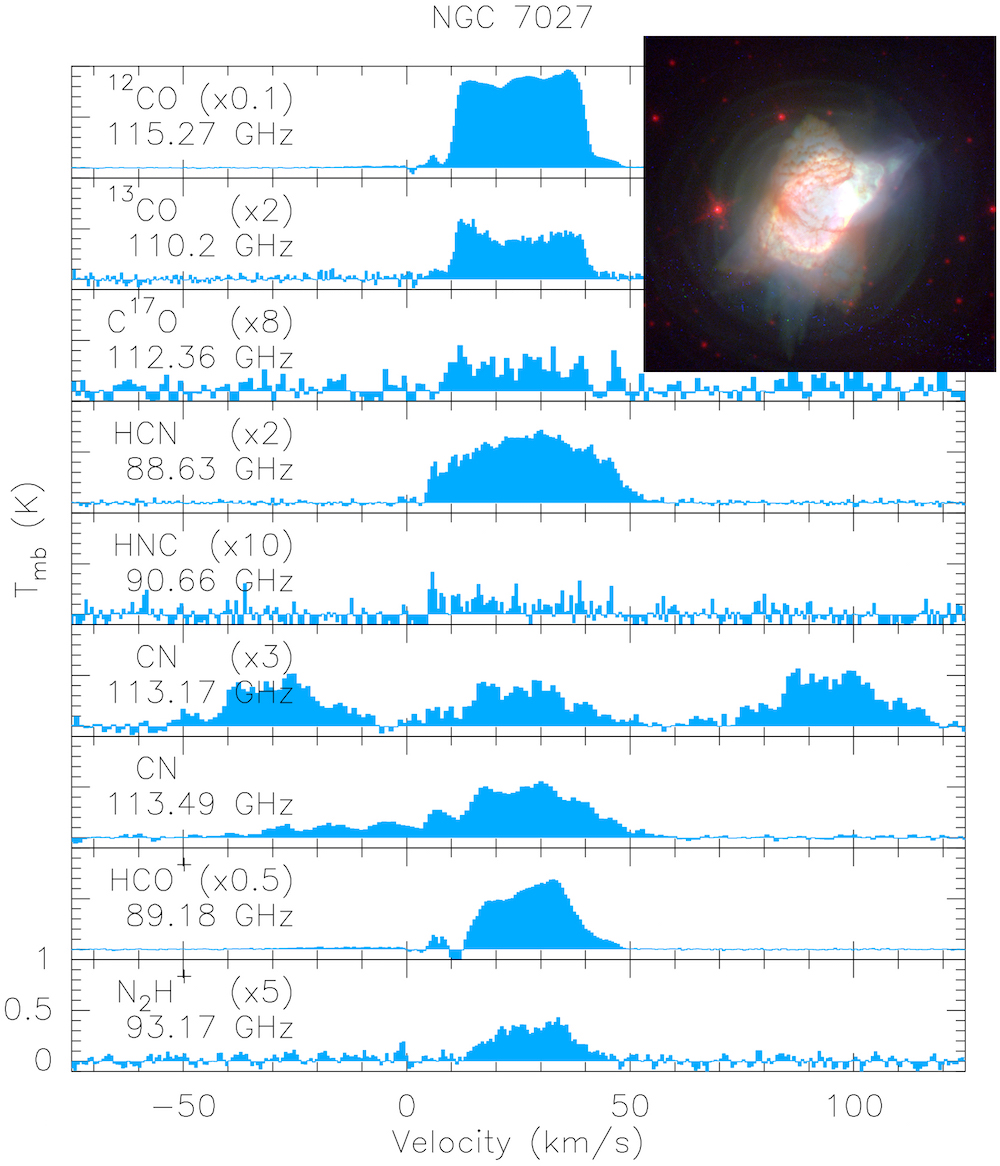
Spectra of the planetary nebula NGC 7027 (Kastner et al. 2018), adapted from an IRAM 30m single-dish molecular line survey (Bublitz et al. 2019). [Inset] Color montage of NGC 7027 images obtained with the HST Wide Field Camera 3 (Kastner et al. 2020, in prep).
[click to enlarge]
Planetary nebulae are the ejected envelopes of intermediate-mass stars in their last stages of evolution. They represent excellent subjects to explore astrophysical plasmas and shock processes, and provide tests of theories of stellar evolution and the enrichment of heavy elements in the interstellar medium.
Planetary nebulae are born from material ejected by asymptotic giant branch (AGB) stars and, through their wide variety of shapes, can also betray the presence of binary companions to the AGB star progenitors. The central star of the nebula – the core of the former AGB star – ionizes the expanding shells and lobes of ejected AGB envelope gas to produce the nebula's iconic bright, optical emission lines, which originate in 10,000 K plasma.
Many planetaries also retain significant quantities of cold, dense molecule-rich material. The chemistries of these regions, as revealed by molecular line emission in the millimeter and submillimeter regimes, can be remarkably rich, as a consequence of irradiation by the central star's ultraviolet, and often X-ray, emission. With their well-resolved structures and well-defined geometries, planetary nebulae hence constitute testbeds for the study of radiation-driven heating and chemistry in molecule-rich environments.
Single-dish surveys and interferometric imaging of planetary nebulae have identified a host of molecular transitions over the past 50 years (e.g., Mufson et al. 1975, Bachiller et al. 1997, Edwards et al. 2014, Schmidt et al. 2016). The figure presents selected bright molecular lines identified in the young and rapidly evolving nebula NGC 7027 (Bublitz et al. 2019).
With the next generation Very Large Array (ngVLA), all of these transitions will be accessible, and they can be mapped at sub-milliarcsecond resolution, exceeding the current state-of-the-art (ALMA) by nearly a factor of 10. This will facilitate exquisitely detailed chemical and kinematic studies aimed at understanding nebular irradiation and shaping processes. Measurement of key isotopologue ratios in planetaries and proto-planetary nebulae will advance knowledge of C and N enrichment of the interstellar medium. Additionally, the ngVLA will push the observable range of resolved objects well out past our solar neighborhood, allowing comprehensive molecular line surveys, which are currently limited to planetary nebulae within about 1 kpc, to extend as far as the Galactic Bulge.
This article inaugurates a regular feature intended to highlight contributions to the ngVLA Science Book. We are especially interested in showcasing work done by early-career researchers. Anyone wishing to volunteer to author a feature should contact Joan Wrobel.
2020 Jansky Lectureship – Call for Nominations
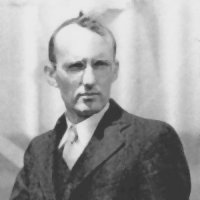
The Karl G. Jansky Lectureship is an honor established by the trustees of Associated Universities, Inc., to recognize outstanding contributions to the advancement of radio astronomy. First awarded in 1966, it is named in honor of the man who, in 1932, first detected radio waves from a cosmic source. Karl Jansky's discovery of radio waves from the central region of our Milky Way Galaxy started the science of radio astronomy.
The 2020 Jansky Lecturer will have made significant contributions related to radio astronomy, and will promote the appreciation of the science of radio astronomy through public lectures at the NRAO sites. A demonstrated ability to engage a wide audience will be a factor in determining the awardee. Visit the Jansky Lectureship website for a list of the previous recipients of this prestigious award.
Additional information, including the nomination and selection process, is available online.
Nominations for the 2020 award should be concise (~1 page) and address both the nominee’s contribution to the advancement of radio astronomy and their potential to increase public appreciation through the Jansky Lecture.
Nominations should be sent to jutley@nrao.edu by 31 March 2020.
NRAO scientific staff will be given an opportunity to vote on nominations received and the results will be included in the recommendation to the NRAO Director.
Recent Media Releases
Career Opportunities
Green Bank Observatory Postdoctoral Research Associate: The Green Bank Observatory (GBO) is looking for an energetic scientist to join the scientific staff as a postdoctoral research associate. The successful applicant will be allocated 50% towards Observatory support (see detail below), and 50% towards carrying out their own independent research program. The appointment will be for two years, with an optional one-year extension upon mutual agreement.
Postdoctoral research associates are also expected to carry out a program of independent scientific research in an area of their choice. Applicants are encouraged to incorporate the Green Bank Telescope into their research program. Opportunities are available to mentor students through a variety of summer and academic year student programs. The appointment includes an annual budget of $10,000 that can be placed toward travel and other research expenses.
Apply online at the GBO Careers page.
Please upload CV, statement of research plans, and letter of application.
Combine the following items into a single PDF file.
Upload by selecting the "Attach Resume/CV" link during the online application process:
- Cover letter
- Curriculum vitae
- Publications list
- A summary of previous, current, and planned research
(max 3 pages of text, including figures and references, 12 pt font).
Each applicant should arrange for letters of reference to be submitted by three individuals (“referees”) familiar with her or his scientific abilities directly to the GB Scientific Search Committee. These letters MUST be received by the application deadline 03/20/2020.
Letters should be submitted to Tracy Samples, Green Bank Site Human Resources Manager, via email at tsamples@nrao.edu using the file name “ApplicantNameGBPostDoc.pdf .” Applicants are responsible for ensuring that letters of reference have been sent by their referees.
Deadline for receipt of applications is March 20, 2020.
From the Archives
Ellen Bouton

[click to enlarge]
About this month's photo: State-of-the-art wiring set-up for meetings! At the annual face-to-face systems administrators meeting, held in Green Bank in 2004, computing staff from all NRAO sites do their best to deal with lack of wifi. In the middle, George Martin (left) and Martin Pokorny. Behind Martin is Chris Clark; beside him with baseball cap is James Robnett; to his left are K. Scott Rowe (barely visible), and Kevin Long. Thanks to Pat Murphy for identifications.
From the Archives is an ongoing series illustrating NRAO and U.S. radio astronomy history via images selected from our collections of individuals' and institutional papers. If readers have images they believe would be of interest to the Archives, please contact Ellen Bouton.

